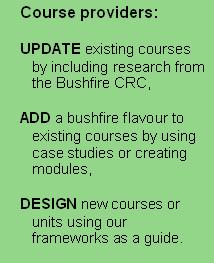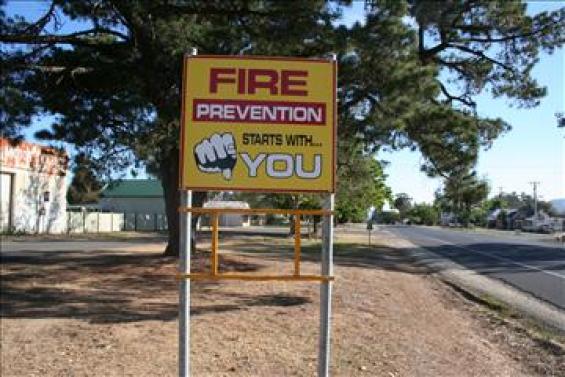Social Sciences and Community Services
 There are two key paradigms which inform the development of community safety policies around bushfires (Handmer 2008). The predominant paradigm is centred on the issue of fire - its impact on assets, the environment, people and their activities. It focusses on a management approach.
There are two key paradigms which inform the development of community safety policies around bushfires (Handmer 2008). The predominant paradigm is centred on the issue of fire - its impact on assets, the environment, people and their activities. It focusses on a management approach.
The other paradigm comes from a more social perspective. It seeks to understand the capacity and limitations of people to adapt to fire. It is interested in understanding the history and rationale of settlements, how and why people build. It looks at building community profiles and looking at ways of developing community capacities.
This second paradigm has emerged as a new focus in bushfire research and one which is having significant impacts on the thinking and operation of land agencies and fire services. There is now a recognition of the important contribution the social sciences can make to community safety.
The following diagram shows seven key perspectives that the social sciences can bring in developing the capacity of land managers, planners and emergency services personnel in the way they work with communities and employees. These are also key areas where case studies from bushfire management experiences may inform community engagement in other sectors. These perspectives aim to give a sense of the whole, rather than be clearly demarcated categories.

Using the framework
A lecturer who is providing a course for the emergency services or land agency sector in order to help them understand a social science perspective to fire management is likely to draw on all seven perspectives in their course design. Psychology lecturers may find the research into decision-making under critical incident conditions useful as case studies when discussing the human factors of decision-making. Likewise, lecturers who run courses in the areas of Community Health and Social Work might find the research on community recovery and resilience useful as case studies.
Potential Students
Undergraduate Students
Participating in undergraduate degrees in the social sciences.
Pre-employment
These students are interested in employment in the areas of community development, education or support, human resource management, occupational health and safety or community health and recovery. Bushfire research may provide useful case studies to help explore key issues. Potential employers include the community engagement and human resources sections within land management agencies, local government and fire services.
Undergraduate Students
Employed in the emergency services sector
These students are looking at developing specific social science skills for working with communities or volunteers as part of middle management positions in the emergency services sector. They are likely to have "come through the ranks" having undergone in-house training through the Public Safety National Training Package. They do not consider themselves "academics" and are looking for courses which provide some Recognised Prior Learning for previous training, and are tailored to fit their learning styles and job needs.
Existing Professionals
Working in land management agencies, local government.
Grad Cert / Dip / Masters
These professionals are likely to have undergraduate degrees in environmental management, biological or earth sciences, or planning. They are looking at gaining social science skills to understand and work with communities and volunteers.
Bushfire Consultants
This is a growing group of people who provide advice to building surveyors, architects, planners, householders, communities and local government. They need to be accredited with the Fire Protection Association of Australia (FPAA). They have varying backgrounds - many coming from fire services and some with environmental, planning or surveying backgrounds. This group are likely to be interested in building their capacity where they have gaps in their previous experience.



